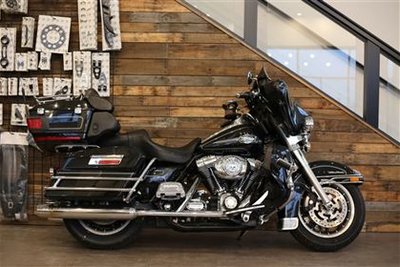
2008 Harley-Davidson FLHTCUI Ultra Classic Electra Glide
$ 13998.00
NOW is the Best time to Buy an inspected pre-owned machine from International Motorsports - Come See Why We Are #1 in - Sales - Parts - Service - We are a Certified Repair and Performance Centre - Easy Financing - Instant Approvals - Low Interest Rates & Payments - We Accept trades! There’s no mistaking Harley heritage with this new 2008 Electra Glide Ultra Classic FLHTCU –it’s all around you. There prominently on the tank, backrest, gas cap cover and elsewhere is the 105th Anniversary badge, a reminder that Harley-Davidson began building motorcycles in 1903. And there under the tank is an air-cooled, 45-degree V-twin engine with two valves per cylinder, attributes that can be traced to the very first H-D V-twin introduced back in 1909. But with Harley-Davidson the more things remain the same, the more they change, and that’s how The Motor Company has managed to survive for lo, this century-plus with the basics still intact. Harley’s success, especially in the past two decades, has been a result of continued incremental change overlaid upon that comfortable, recognizable base. Take the Electra Glide FLH, for example. It was first produced in 1966, and we’ve all grown to recognize its signature fork-mounted, bat-wing fairing. Today, if you were parked beside the road and saw this 2008 Electra Glide Ultra Classic rumble past you, followed immediately by a 1984 Electra Glide Classic, it would take a sharp eye to distinguish between the two. Once they pulled over, however, the differences would leap out at you in multiples. 2008 Harley-Davidson Ultra Classic Electra Glide With a full fairing, lowers and luggage the Ultra is a comfortable traveler. In 1984, features such as Elastomer rubber engine mounting and fully enclosed chain final drive were recent innovations, and the 80-cubic-inch Evolution engine (the one that was to save Harley-Davidson from extinction) had just been introduced. In the intervening years the entire Harley line has gone to belt final drive and electronic fuel injection. The Electra Glide’s fairing has been improved and updated. There’s now a full sound system. The saddlebag lids are now attached and can no longer be lost, the brakes now have four-piston rather than single-piston calipers, and fairing lowers are standard on the Ultra. And in case you feared that the rate of change had slowed in recent years, for 2007 the E-Glide was given the new Cruise Drive six-speed transmission (which debuted on other models the previous year), and the Twin Cam 88-inch engine was upgraded to 96 cubic inches. This was accomplished by leaving the bore intact, but adding almost 10mm to the stroke. For 2008 fuel capacity has grown by one gallon, and various models (including the Ultra) are available with anti-lock brakes. It just goes to show that the rate of change has actually increased in recent years. That 96-inch motor (1,584cc) offers a bore and stroke of 95.25 x 111.25mm, figures that indicate a torquey stroker rather than a revver. Sure, it’s still air-cooled and its valves are actuated by pushrods with hydraulic lifters that never need adjustment, but power has been tweaked in unexpected ways. Two years ago when we tested the 2006 Ultra Classic its 88-inch Twin Cam motor produced 65 horsepower at 5,700 rpm on the Borla Performance dynamometer, and 67.4 lb-ft of torque at 3,800 rpm. Now, despite gaining 8 cubic inches of displacement, horsepower has actually fallen to 62.4 at 5,200 rpm, but torque is up to 77.8 lb-ft at 3,600 rpm. That’s a whopping 15 percent boost, and anyone who rides a Harley can confirm that torque is what it’s all about. Not only that, but the Ultra’s flat torque curve delivers more than 70 lb-ft from 2,000 on up to 4,400 rpm. Hit the starter button, and after a loud whump from the starter damper the electronic sequential port fuel injection helps the engine fire up immediately…unless you were foolish enough to forget to pack the hands-free security fob that’s part of the optional Smart Security System. It’s a passive key fob that must be within several feet of the bike or nothing will happen except the turn signals will simply flash at you angrily. When the fob is more than 8 feet away, the security system arms itself and disables the ignition. When the bike is disturbed, the signals flash; a siren alarm is optional. Should you lose the
